Reviving Tradition: Female Brewmaster, a Toji, Wakabayashi Mami
Jul 25,2024
Reviving Tradition: Female Brewmaster, a Toji, Wakabayashi Mami
Jul 25,2024
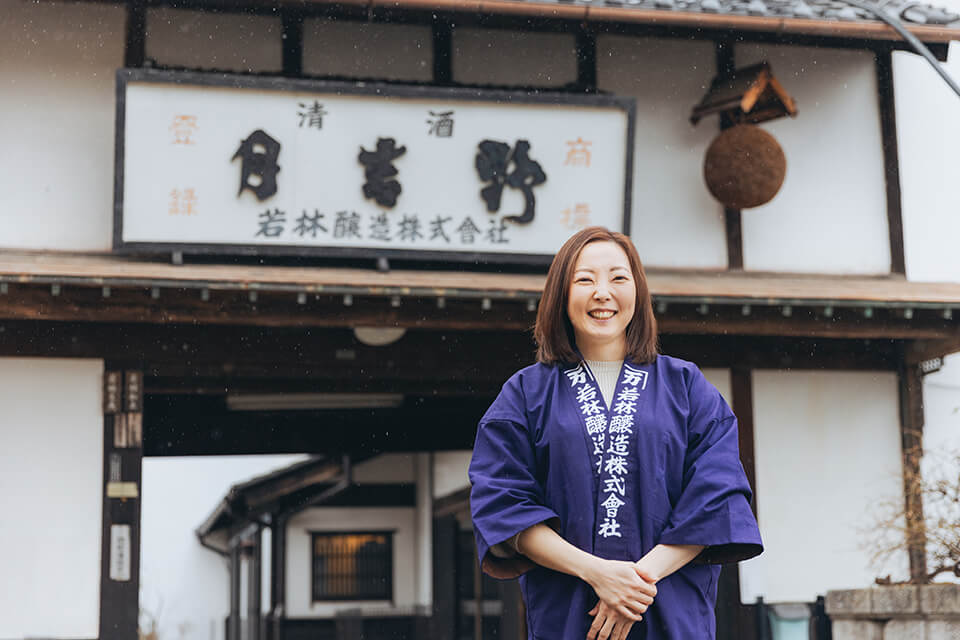

The Shiodadaira district of Ueda, Nagano Prefecture, is known as the Kamakura of Shinshu — Shinshu being the traditional name of Nagano — after the city that was the political and religious center of medieval Japan. That’s due to the many Shinto shrines and Buddhist temples built here over the centuries. The local train connecting Ueda and Bessho-Onsen stations traverses the rural landscape surrounded by mountains. It’s an idyllic community that looks like a vignette of old Japan. This is where Wakabayashi Brewing was founded in 1896. Its gateway, bearing a sign emblazoned with the words Seishu Tsukiyoshino (“Tsukiyoshino Sake”), is adorned with a ball of cedar needles identifying the establishment as a brewery. Proprietor and brewmaster Wakabayashi Mami comes out to greet me. Mami hails from a family of brewers, but in her student days, she never dreamed that she would one day be running the brewery herself. She found a job in Tokyo instead. But then in 2016, she made up her mind to take over the family business. She attracted considerable attention at the time, for she was the brewery’s first female proprietor and brewmaster and only the seventh female brewmaster in Nagano. We asked her about the kind of sake she aspires to make.
Sometimes you need to get away from a place to understand how precious it is. Something like that happened to Wakabayashi Mami. Mami was born and brought up in the city of Ueda, Nagano Prefecture. In her student days, English was her favorite subject, and she adored Western culture and music. Though aware that she hailed from a long line of sake brewers, she was more interested in the outside world. On graduating from high school, she enrolled in a university in Tokyo. Her major was English. Then, when she was visiting Seattle, USA, on a short-term language study program, this happened.
“I was chatting with some classmates of my own age, and I happened to mention that I was from a family of sake brewers. I just said it in passing, but my friends were like, ‘Really?’ ‘That’s incredible!’ They kept asking questions. ‘How is sake made?’ ‘What’s it like working at a sake brewery?’ But I was stumped for answers, even though this was my own family we were talking about. My family ran a small brewery, but this conversation made me realize that in non-Japanese eyes, we were keepers of a piece of Japan’s cultural heritage. Yet despite being Japanese, I couldn’t explain a thing about Japanese culture. I was so embarrassed.”
Despite these sentiments, Mami ended up getting a job in Tokyo after graduating from university. Then one day she was reading the online edition of the hometown newspaper, when she came across an article about Wakabayashi Brewing. Wakabayashi Brewing, it said, had started making and selling the sweet fermented beverage amazake.
“My parents are working hard, I thought. That got me thinking more about my family back home.”
Domestic shipments of sake peaked at more than 1.7 million liters in 1973, then declined steadily thereafter in the face of competition from other alcoholic beverages. Long-established sake brewers started closing down as times changed. To stay in business, Wakabayashi Brewing had to think of ways to cut costs and streamline operations. Instead of brewing in house, therefore, it outsourced most of its operations (which meant engaging in joint production and pooling sales). In a bid to develop new sales channels, moreover, it began producing amazake and processing locally grown fruit into juice. Mami returned home frequently even after she started working. On one such visit, she happened to overhear her parents discussing something that left her dumbfounded.
“They were talking about closing down the brewery once they retired. The first thing I thought was, ‘What a shame that would be!’ The main building was an imposing piece of historic architecture. And for me, it was where I was born and raised. I was frightened of losing my identity. If ownership passed to someone else, the building itself might end up being demolished. Doing away with the brewery might be simple, but once it was gone, it could never be brought back. If the problem was that there was no one to take over the business, I thought, I’d take it over myself.”
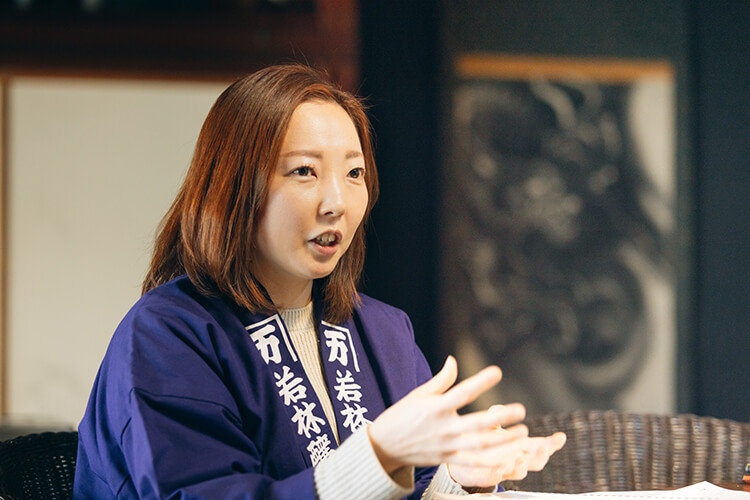
Mami resolved to take over the family brewery in its hour of peril.
Mami quit her job in Tokyo and returned to her home in Ueda to take over the family business. She hadn’t, however, yet made up her mind to completely overhaul it.
“I was back, but I hadn’t the faintest idea how sake was made. The place where I’d gotten a job in Tokyo was a women’s apparel company. It manufactured clothes from scratch, starting with searching for materials and creating patterns. Brewing sake was likewise a form of manufacturing. I wanted to properly study every aspect of it, including the ingredients and production methods used.”
Mami decided to apprentice at the largest brewery in the city, Shinsyu Meijyo. There she met a brewmaster who would change her life.
“I was just happy to take over the family brewery. But thanks to him, I decided to become a brewmaster myself.”
If you’re a sake lover, you probably know that the brewmaster — toji in Japanese — plays a key role in making sake. Sake making is a complex and delicate process. The brewmaster has to keep an eye on every stage of the process, from the processing of the ingredients to the finished product. Sake making is performed by a team of brewers called kurabito, with the brewmaster at their head.
Here’s a quick overview of the typical sake-making process. It begins with milling brown rice. Then the rice is washed, soaked, and steamed. Some of the steamed rice is taken to the koji-making room to be used for making koji (rice malt). There it is inoculated with spores to produce koji. Once the koji is ready, shikomi (mashing) begins. Steamed rice, koji, water, and lactic acid are combined with yeast, the yeast is propagated, and the mixture is slowly fermented. The resulting moromi or mash is pressed to separate the sake from the sake lees. Then the sake is pasteurized, stored, and bottled. It’s now ready to drink.
The brewmaster has complete discretion over which ingredients to use at each stage and what to do when. That’s what gives each brewery’s sake its distinctive character and taste.
The brewmaster is thus the linchpin of the sake-making process. In the past, brewmasters typically made a living by farming from spring to autumn and producing sake in the winter months. Most started out working as kurabito and become brewmasters after gaining enough experience. Increasingly, though, there are people like Mami who study to become brewmasters on succeeding to the family brewery.
The brewmaster whom Mami met was what is called a traveling brewmaster. He spent most of the year farming rice; then in the off-season after the harvest was over, he would gather a team of kurabito and come the brewery to make sake. Once he’d finished making sake, he would head back to his farm.
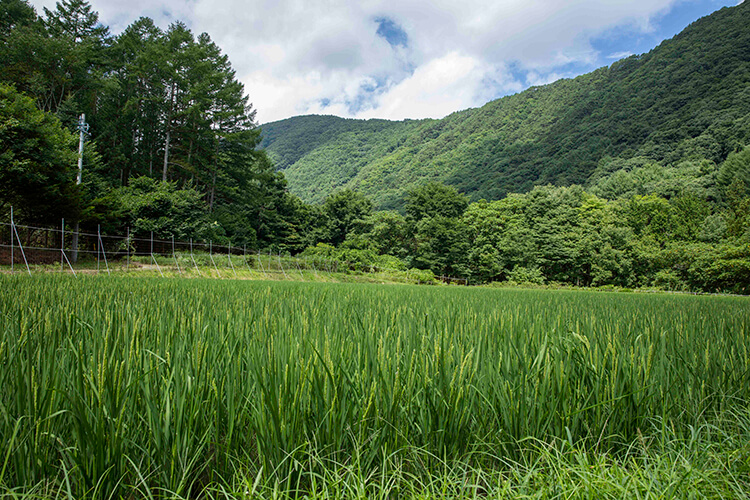
A sake-rice paddy. The system of toji (brewmasters) and kurabito (brewery workers) emerged during the Edo period (1603–1867). Sake breweries needed workers. Farmers sought work in the months when there was little to do on the farm. The interests of the two thus coincided, and hiring migrant laborers to brew sake became widespread.
“The brewmaster I met during my apprenticeship was a truly remarkable man. He was seventy-eight at the time. He started making sake when he was fifteen and had over sixty years’ experience. He’d won gold year after year at competitions like the Annual Japan Sake Awards. He had a team of seven kurabito working under him, and I joined them. I didn’t know how to do anything yet, so initially I beavered away at chores like the cleaning and the washing up. But I was determined to learn from the man, and I was curious. So whenever I found a spare moment on the job, I would observe the sake-making process.”
In the sake-brewing business, no one teaches you the ropes. You just have to watch and steal whatever knowledge you can. There’s no job manual for being a brewmaster. All you have to work with is your own experience and the skills you’ve mastered. Brewing is an art, and Mami became increasingly fascinated by it. Moreover, she thought the brewmaster “cut a dashing figure” with his professionalism. He was a man of few words, yet when he did speak, he always hit the nail on the head. Mami was determined to learn the ropes, and the brewmaster noticed. He started calling her over and saying, “Get a look at this.” What they were engaged in was basically traditional sake making, even if it did incorporate new techniques. It was done the time-honored way, which took a lot of time and effort.
“Slowly but surely, he began showing me how to perform various tasks and asking me to do this or do that. But just when I thought I was finally going to be able to learn something, the brewmaster suddenly collapsed on the job and passed away.”
He collapsed in the room where the koji is made, an essential part of the sake-making process. The koji-making room an important place, indeed one of a brewery’s main assets. Mami was the first person to find him after he collapsed. She accompanied him on the helicopter when he was airlifted to hospital.
“I was in total shock. So many thoughts were racing through my mind. He’d collapsed in the koji-making room, of all places. He’d been a true brewmaster to the end. And I’d been present at his death. That must mean something. I guess I’m destined to be a sake maker.”
It was a tragic turn of events, but it strengthened Mami’s determination to become a brewmaster. She kept studying, and two years into her brewery apprenticeship, she brewed her first batch of sake at the family brewery.
“It turned out pretty well considering it was my first try. When I asked myself why, I realized it was thanks to the koji. What I’d used was koji made at the brewery I’d been apprenticing at. We didn’t make our own koji anymore. It then occurred to me that you’ll never understand sake making unless you start with making koji. That’s what led us to start making sake in house again instead of outsourcing production.”
In 2016, the koji-making room, which hadn’t been used in some fifty years, was refurbished, the brewing facilities were put in working order, and the brewery began producing sake in earnest. Mami was twenty-nine at the time.

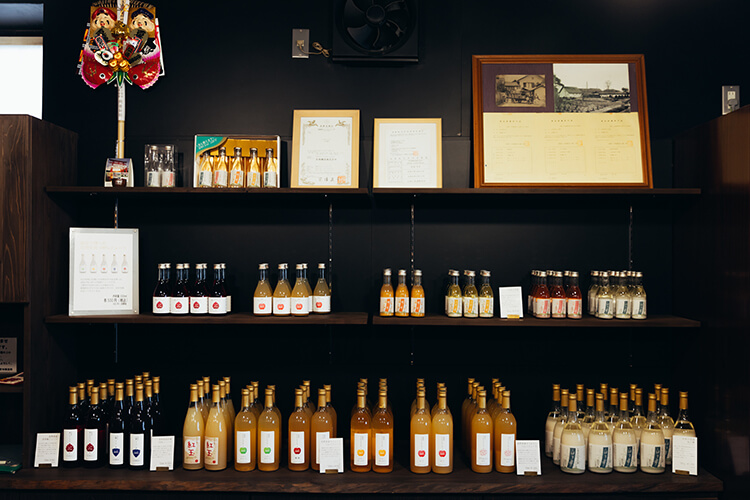
Left: From left, Tsukiyoshino Sakura, Aka, Moegi, Makoto, and Shiro
Right: The brewery shop stocks amazake and juice as well as sake.
Today, the shelves of the brewery shop at Wakabayashi Brewing are temptingly lined with bottles of Tsukiyoshino-brand sake bearing brightly colored labels. Each sake is named after a color or an aspect of nature: Shiro (“white”), Moegi (“yellowish green”), Hana (“flower”), Midori (“green”), Sora (“sky”). The brand name “Tsukiyoshino” is now written in hiragana, rather than kanji as before, creating a softer, more feminine effect. Now that Mami is brewmaster, what kind of sake does she aspire to make?
“Our sake has three hallmarks. It has a refreshing taste. It’s free of off-notes. And it’s easy to drink. Plus it comes in several variations: sweet, dry, gentle, robust. I decided to make this kind of sake for two reasons. First, I thought it tasted good when I drank it myself. At my place, we have a drink with dinner each evening. My family loves sake, and I wanted to make a sake that they would enjoy. Second, it was for the sake of the traditional inns at the nearby Bessho Onsen hot springs that had been stocking our sake for decades. I thought that guests staying there would love an eminently drinkable sake that could easily be paired with food.”
The brewery has for years used two brands of Nagano rice for brewing sake, Miyamanishiki and Hitogokochi. Since Mami took over the business, she’s directly contracted farmers in Ueda and Tomi to supply rice for their sake.
“When a sake maker personally asks a farmer to grow rice for them, I think the farmer has a different level of dedication. It’s great being able to swap information directly. You can ask how the rice crop is this year. Sometimes I visit the rice paddies, and I learn a lot from the farmer. The paddy fields in this area are increasingly being developed for housing. I’d like to do my small part to protect them.”
To bring out Tsukiyoshino’s true character, there are certain aspects of the production process on which Mami refuses to compromise.
“Basically, there are two. After being polished and soaked, the rice is steamed. At that stage, we cool the rice naturally by transferring it all to a drying bench. The other thing is when pressing the sake from the moromi mash at the end. Usually, the job is done with an automated filter press. But we employ a time-honored technique called funeshibori or ‘vat pressing.’ The mash is placed in sake bags and left for twenty-four hours to slowly compress under its own weight. Finally, a machine is used to apply pressure. These techniques are usually only used for high-grade sakes like daiginjo, but at our brewery we use them for all our sake. The primary reason for that is because that way we can produce under sanitary conditions. Also, it was what we needed to do to make the sake I wanted to.”
Mami has always remained true to her vision of what she wants to accomplish. Now that she’s an experienced brewmaster, she radiates a beauty that commands respect.

When Mami became brewmaster eight years ago, she refurbished the koji-making room, which hadn’t been used in almost fifty years, and started full-scale sake production in-house.
In November 2023, Wakabayashi Brewing had cause for celebration. All the sakes it had entered in the San Francisco International Wine Competition held in California, USA, had won medals. One of them bagged the top prize, the double gold. In fact, this was the second year running that the brewery had brought home prizes: it had claimed gold and silver medals on its first foray into the competition in 2022. So when did it start expanding overseas?
“Actually, I was interviewed by an inflight magazine when I’d just become brewmaster. I talked about my background and my passion for sake making. Well, this person who ran an apparel company in the United States read the article and contacted me. They said they wanted to work on something relating to Japanese culture. I asked them to be our export partner, and an agreement was reached to sell Tsukiyoshino in the US. I’d never imagined that our sake would end up being sold in the US. It was beyond my wildest dreams, yet now, all of a sudden, it had come true. In the end, it took three years for our sake to be released there. Then, when it finally started being stocked by restaurants on the West Coast, Covid struck. Almost all the restaurants closed down, and sales dropped off.”
Despite that setback, the sake sold successfully in the US market and was entered in various competitions by the export partner. The sake brewed for export is called Moon Bloom, with a label depicting the moon, a woman, and cherry blossoms. It has a reputation for pairing well with quintessentially American dishes like steak or seafood grill. And the good news has kept coming. In 2024, Tsukiyoshino Makoto won gold at the Annual Japan Sake Awards.
“I think we were really lucky to get the chance to export our sake. But I’m the type of person who likes to do a thorough job of what’s in my own purview rather than constantly expanding my horizons. One thing I find gratifying lately is that dealers and liquor stores that sell our sake properly appreciate its characteristics and virtues. Shipments are slowly but steadily increasing, which is nice.”

At the brewery shop. Displayed on the wall is a calligraphy reading “Ten Thousand Years Immortal Sake” brushed by Koga Michitsune, a politician who lived from 1842 to 1925. It was a gift to the brewery’s founder.
Mami has ventured into the American market, but does she network with people of her own age who, like her, have succeeded to a family brewery?
“The sake industry is a close-knit community. I compare notes with my fellow brewers all the time, especially locally based ones. We don’t talk so much about selling our product overseas as how our generation should breathe new life into the sake industry as a whole.
“To talk about Nagano for a moment, the place has natural beauty and abundant water resources, and it offers a favorable environment for paddy farming. Being able to source ingredients right here in the prefecture is a big plus. I want to tout these advantages of Nagano. There still isn’t much networking here between different sectors. When local farmers had misshapen fruit that couldn’t be sold, though, my parents bought it from them wholesale and turned it into juice. Maybe we could accomplish a lot if information were exchanged across industry boundaries that way. For example, demand for sake lees is declining, which is a headache for a lot of sake breweries. It would be great to discuss whether there are other good ways to recycle them.
“I look forward to making new products and taking on new challenges every year. In the process, I hope to engage with a wide range of people so they can get to know who we are. After all, life is worth living to the full.”
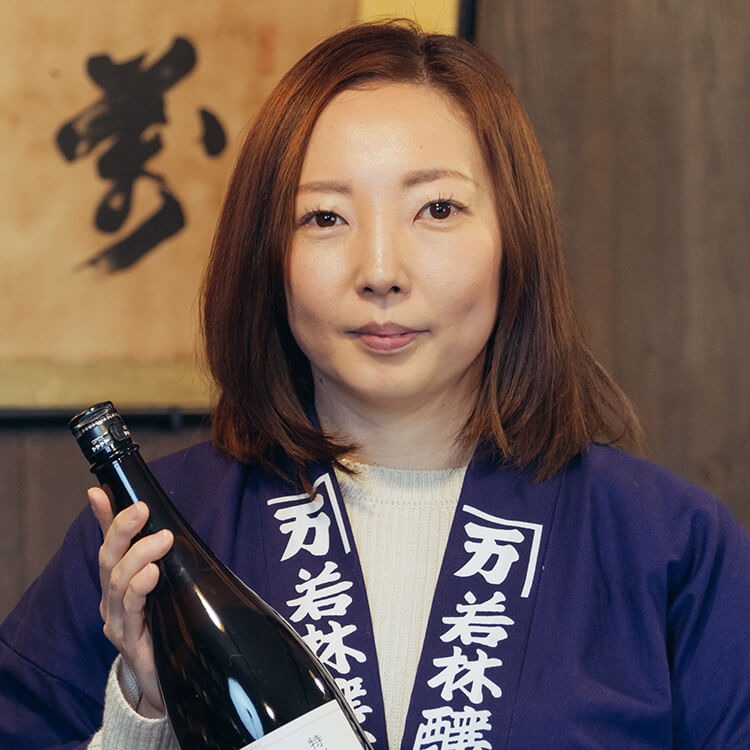
Mami became aware of the value of Japanese culture and her own family’s brewery when visiting Seattle, USA, on a study program. She was a student at a university in Tokyo at the time. After graduating from university, she joined a women’s apparel company. She then returned to her hometown to take over the family business. Starting the same fall, she spent three years learning the basic of sake making at Shinsyu Meijyo in Ueda, Nagano Prefecture. In 2016, after completing her sake-making apprenticeship at Shinsyu Meijyo, she began making sake as brewmaster of Wakabayashi Brewing. In 2018, she entered the sake exporting business. In 2019, she embarked on organic farming of Hitogokochi, a type of sake rice, in Shiodadaira. In 2023, Moon Bloom Daiginjo won the top prize, double gold, in the sake category of the San Francisco International Wine Competition. Tsukiyoshino Makoto 2023 won gold at the Annual Japan Sake Awards in 2024.
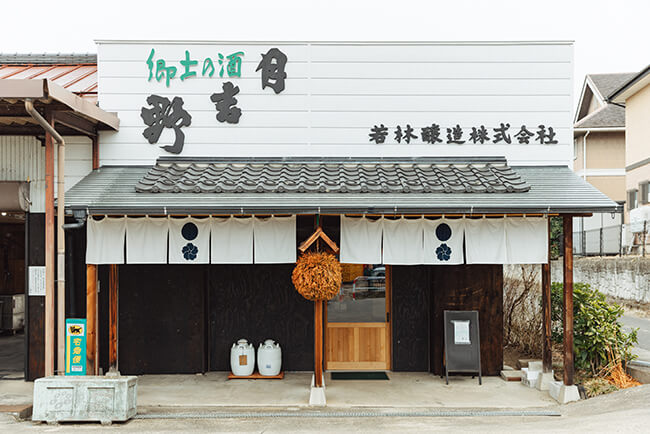
The Wakabayashi Brewing website:
https://en.tsukiyoshino.com/
Online shop:
https://en.tsukiyoshino.com/onlineshop